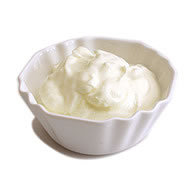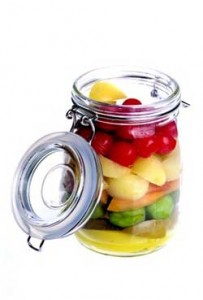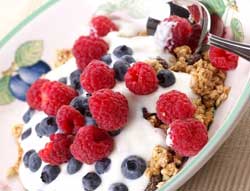Cultured Foods
by Cathe Olson
Naturally cultured or lacto-fermented foods contain enzymes and bacteria that help digest food and eliminate wastes. They also build up friendly bacteria in the intestines that aids digestion, supports your immune system, and increases the propagation of vitamin B12. They are especially helpful during pregnancy when your digestive system may be sluggish. Cultured foods can help prevent constipation and other digestive problems, and are useful in preventing and treating yeast infections. After taking antibiotics, lacto-fermented foods help to replace the beneficial bacteria that was destroyed by the medication.
The term ‘fermented foods’ may sound unappetizing but yogurt, miso, pickles and sauerkraut are delicious and easy to incorporate into your diet. Here are a few ideas:
Yogurt
When people think of cultured foods, they usually think of yogurt made from milk, however, there are yogurts made from soy and rice. Be aware, however, that many are high in sugar, which feed the bacteria you don’t want, like yeast. It’s best to get plain varieties and add fresh fruit or a little jam to sweeten it. Yogurt is also great smoothies. Check the label and be sure it says “live cultures” otherwise there is no benefit. Yogurts can also be made from nuts and seeds, like the Cashew Yogurt recipe that follows.
Cashew Yogurt

This creamy, nondairy yogurt just takes a few seconds to mix up. The incubation period is 8 to 24 hours depending how warm you keep it.
- 1 cup raw cashews
- 1 cup water
Place cashews in blender and grind to a coarse powder. Add water and blend until smooth. It should have a consistency of heavy cream. Pour mixture into a jar and place in warm location (70ºF to 100ºF). Cover with a light towel or napkin. Start checking the yogurt after 6 hours. First you should notice bubbles forming. When it has formed thick curd with a layer of liquid (whey) on the bottom, cover and transfer to refrigerator. Chill for at least one hour. When ready to eat, stir the whey and yogurt together. Add a little honey, agave nectar, maple syrup, molasses, fruit, or jam if desired. Yogurt will keep refrigerated up to a week.
Makes 2 cups
Note: Choose a place where the temperature will remain constant to incubate your yogurt. I like to fill a small cooler with warm water and place the jar in the water (make sure the water is below the level of the jar). Another good place is on top of the pilot light in a gas stove. As long as the temperature in your house is at least 70ºF, you can place the jar anywhere. Keep in mind, the lower the temperature, the longer the incubation. At 70ºF, it will take about 20 hours.
Miso
Miso is a good source of vegetable protein because it contains eight amino acids. It has a salty-sweet taste that adds flavor to soups, sauces, and salad dressings. Buy unpasteurized and naturally fermented miso which contains live enzymes. Miso is made from a variety of grains or beans and ranges from white to deep brown. Basically, the lighter the color, the sweeter and lighter the taste. Never boil miso, as that will kill the beneficial bacteria. When using in soup or sauce, add it after soup or sauce is cooked. Remove the dish from heat. Mix desired amount of miso with a small amount of water or soup broth until it forms a smooth paste. Stir paste into the soup or sauce. When reheating, do not boil. Miso is available in the refrigerated and macrobiotic foods sections of natural foods stores and some supermarkets.
Tahini-Miso Sauce
This white sauce is great over tempeh, vegetables, grains, or pasta.
- 1 cup water
- 2 tablespoons arrowroot powder
- 1/4 cup tahini
- 1 tablespoon miso
- Pinch ground nutmeg
- 1/4 cup minced fresh parsley (optional) Black pepper to taste
Whisk or blend all ingredients together. Pour into saucepan. Heat over low heat until thickened.
Makes about 1 cup
Miso-Noodle Soup

This is a soothing soup that is great for upset stomachs or jangled nerves. I especially like it with brown rice pasta.
- 5 1/2 cups water
- 2 tablespoons chopped wakame
- 1 carrot, thinly sliced
- 1 clove garlic, minced
- 3 green onions, thinly sliced
- 1 cup chopped kale, cabbage, watercress, or other green
- 1/2 cup snow or snap peas
- 1/2 cup small uncooked pasta noodles
- 8 ounces tofu, diced
- 2 tablespoons miso
- Soy sauce to taste
Place water and sea vegetable in medium-size pan. Cover and bring to a boil over high heat. Add remaining ingredients and simmer uncovered 10 minutes, or until pasta is just cooked. Remove from heat, stir in miso. Season with soy sauce if desired.
Makes 6 servings
Naturally Fermented Vegetables and Pickles
Vegetables ferment best in brine made from natural sea salt. The brine protects the vegetables from rot and encourages the growth of the beneficial bacteria lactobacilli. Most pickles and sauerkrauts found in stores are made with vinegar and/or are pasteurized so they are devoid of any of the beneficial bacteria. More and more natural food stores, however, now offer unpasteurized cultured vegetables in their refrigerated section. It’s not difficult to make your own pickles and it’s a great way to preserve your summer harvest. Check out the books in the resources section for more recipes.
Carrot-Wakame Pickles 
These pickles, rich in beta carotene and minerals, are great on sandwiches, salads, or with meals.
- 8 cups shredded carrots
- 1 cup wakame, soaked in water 15 minutes
- 3 tablespoons sea salt
- 3 cloves garlic, sliced (optional)
- 2 tablespoons diced ginger (optional)
Toss all ingredients together in large bowl. Use a wooden spoon, meat pounder, or whatever works to pound carrot mixture until juices are released and volume is reduced to about 4 cups. This takes 5 to 10 minutes. Let your children take turns. Even a toddler will enjoy doing this. Transfer mixture to quart-size jar. Press down mixture until liquid rises above it. Cover tightly and place in cool spot (not refrigerator) for 3 days. Transfer to refrigerator. Flavor will improve with age. Pickles will last in refrigerator for months.
Makes about 1 quart
Sauerkraut
- Naturally fermented sauerkraut is full of vitamin C. Eat it on sandwiches, veggie hot dogs, salads, or as a side dish.
- 1 large head cabbage
- 2 tablespoons sea salt
Remove outer leaves of cabbage and reserve. Remove core from cabbage. Slice the cabbage very thinly. (I use a food processor.) Toss cabbage and salt together in large bowl. Use a wooden spoon, meat pounder or whatever works to pound cabbage until juices are released and cabbage volume is reduced to about 4 cups. This takes 5 to 10 minutes. Let your children take turns. Even a toddler will enjoy doing this.
Transfer cabbage to quart-size jar. Roll up the reserved cabbage leave and place over cabbage in jar. Press down until liquid rises above cabbage. Cover tightly and place in cool spot (not refrigerator) for 3 to 5 days. Taste it periodically. When it tastes tangy, remove cabbage leaves and transfer jar to refrigerator. Flavor will improve with age. Sauerkraut lasts in the refrigerator for months. Rinse sauerkraut in cold water before eating because it is very salty.
Makes about 1 quart
Recipes from The Vegetarian Mother’s Cookbook copyright © 2005 by Cathe Olson.


